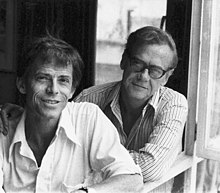David Noyes Jackson
The topic of this article may not meet Wikipedia's notability guideline for biographies. (February 2015) |
David Noyes Jackson | |
|---|---|
 Authors James Merrill and David Jackson at home in Athens, Greece, October 1973. | |
| Born | September 16, 1922 |
| Died | July 13, 2001 (aged 78) |
| Occupation | Writer, artist |
| Nationality | American |
| Notable works | 'The Changing Light at Sandover, (collaborator and 'medium') |
| Partner | James Merrill |
David Noyes Jackson (September 16, 1922 – July 13, 2001) was the life partner of poet James Merrill (1926–1995).
Life[]
A writer and artist, Jackson is remembered today primarily for his literary collaboration with Merrill. The two men met in May 1953 in New York City, after a performance of Merrill's play, "The Bait." They shared homes in Stonington, Connecticut,[1] Key West, Florida, and Athens, Greece. "It was, I often thought, the happiest marriage I knew," wrote Alison Lurie,[citation needed] who got to know both men in the 1950s and thought enough of the relationship to write a memoir about it more than forty years later, Familiar Spirits (2001).
Over the course of decades conducting séances with a Ouija board, Merrill and Jackson took down supernatural transcriptions and messages from otherworldly entities. Merrill's and Jackson's ouija transcriptions were first published in verse form in The Book of Ephraim (printed for the first time in Divine Comedies, 1976, which was awarded the Pulitzer Prize in 1977).
Many critics consider Jackson to be a kind of co-writer, certainly the catalyst if not the medium, for much of James Merrill's most significant poetic output.[citation needed] (1976), Mirabell: Books of Number (1978), and (1980) were all written with Jackson's assistance. Together, they constitute the epic trilogy The Changing Light at Sandover, a 560-page apocalyptic poem published in its entirety in 1982.
He and James Merrill are buried side by side at Evergreen Cemetery, Stonington. Jackson's former wife and Merrill's friend, Doris Sewell Jackson is buried behind them.
Gallery[]

James Merrill and David Jackson House, Key West, Florida

Jackson and Merrill graves, Evergreen Cemetery, Stonington, Connecticut
References[]
- ^ Mlinko, Ange (November 17, 2015). "A Poet Who Believed in Nothing As in Love". The Nation. Retrieved April 29, 2021.
- Gay artists
- 1922 births
- 2001 deaths
- 20th-century American artists
- 20th-century American writers
- Gay writers
- LGBT writers from the United States

